load capacity FIAT FREEMONT 2011 Owner handbook (in English)
[x] Cancel search | Manufacturer: FIAT, Model Year: 2011, Model line: FREEMONT, Model: FIAT FREEMONT 2011Pages: 267, PDF Size: 5.16 MB
Page 76 of 267
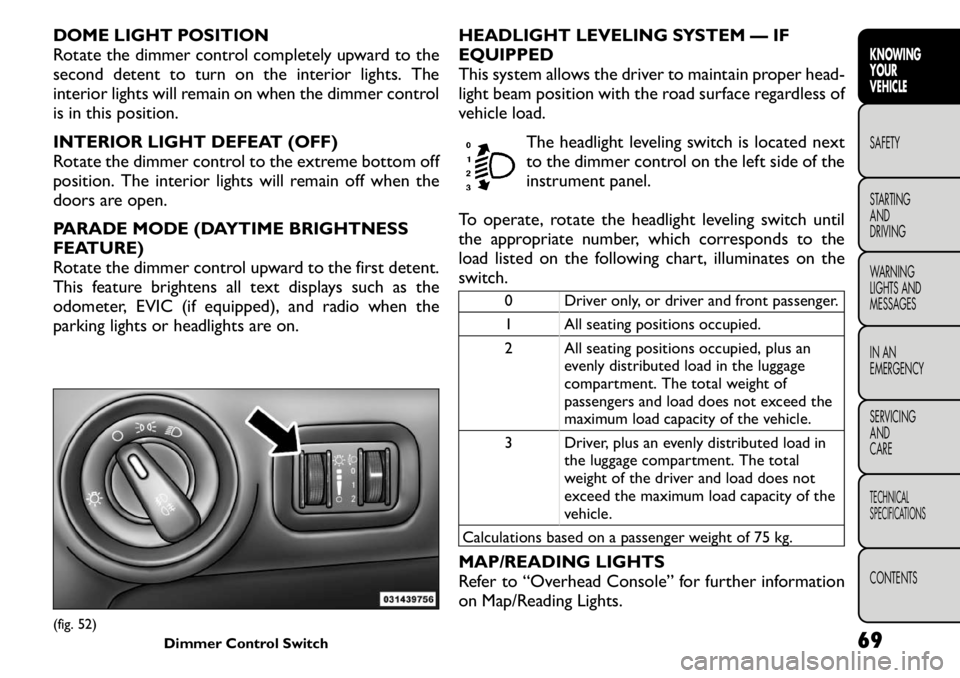
DOME LIGHT POSITION
Rotate the dimmer control completely upward to the
second detent to turn on the interior lights. The
interior lights will remain on when the dimmer control
is in this position.
INTERIOR LIGHT DEFEAT (OFF)
Rotate the dimmer control to the extreme bottom off
position. The interior lights will remain off when the
doors are open.
PARADE MODE (DAYTIME BRIGHTNESS
FEATURE)
Rotate the dimmer control upward to the first detent.
This feature brightens all text displays such as the
odometer, EVIC (if equipped), and radio when the
parking lights or headlights are on.HEADLIGHT LEVELING SYSTEM — IFEQUIPPED
This system allows the driver to maintain proper head-
light beam position with the road surface regardless of
vehicle load.
The headlight leveling switch is located next
to the dimmer control on the left side of the
instrument panel.
To operate, rotate the headlight leveling switch until
the appropriate number, which corresponds to the
load listed on the following chart, illuminates on the
switch.
0 Driver only, or driver and front passenger.
1 All seating positions occupied.
2 All seating positions occupied, plus an evenly distributed load in the luggage
compartment. The total weight of
passengers and load does not exceed the
maximum load capacity of the vehicle.
3 Driver, plus an evenly distributed load in the luggage compartment. The total
weight of the driver and load does not
exceed the maximum load capacity of the
vehicle.
Calculations based on a passenger weight of 75 kg.
MAP/READING LIGHTS
Refer to “Overhead Console” for further information
on Map/Reading Lights.
(fig. 52) Dimmer Control Switch
69KNOWING
YOURVEHICLESAFETY
STARTING ANDDRIVING
WARNING
LIGHTS AND
MESSAGES
IN AN
EMERGENCY
SERVICING AND
CARETECHNICAL
SPECIFICATIONSCONTENTS
Page 111 of 267
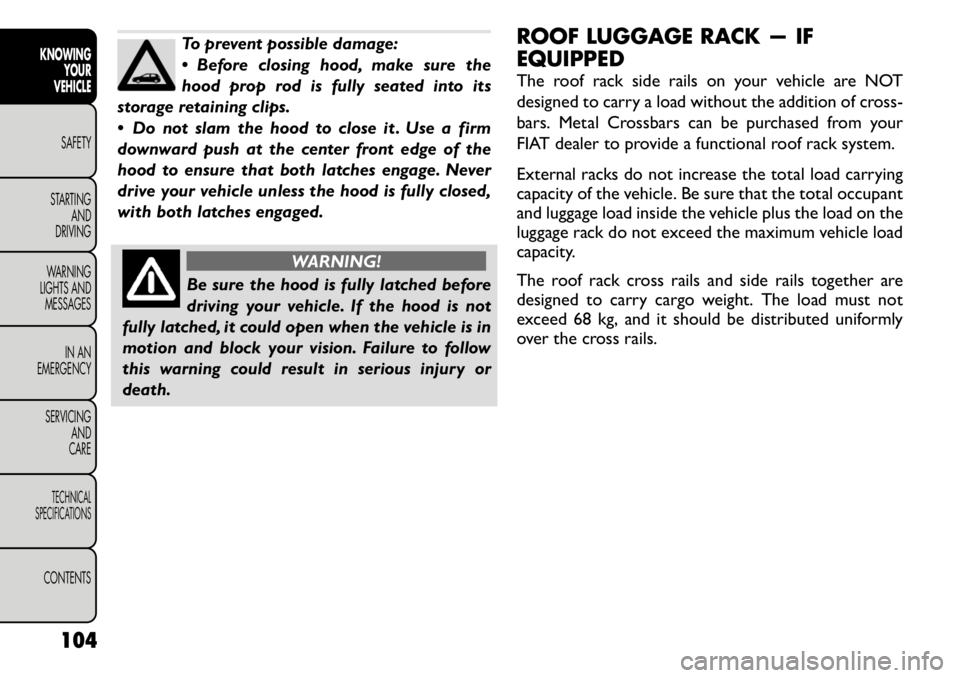
To prevent possible damage:
Before closing hood, make sure the
hood prop rod is fully seated into its
storage retaining clips.
Do not slam the hood to close it . Use a firm
downward push at the center front edge of the
hood to ensure that both latches engage. Never
drive your vehicle unless the hood is fully closed,
with both latches engaged.
WARNING!
Be sure the hood is fully latched before
driving your vehicle. If the hood is not
fully latched, it could open when the vehicle is in
motion and block your vision. Failure to follow
this warning could result in serious injury or
death. ROOF LUGGAGE RACK — IF EQUIPPED
The roof rack side rails on your vehicle are NOT
designed to carry a load without the addition of cross-
bars. Metal Crossbars can be purchased from your
FIAT dealer to provide a functional roof rack system.
External racks do not increase the total load carrying
capacity of the vehicle. Be sure that the total occupant
and luggage load inside the vehicle plus the load on the
luggage rack do not exceed the maximum vehicle load
capacity.
The roof rack cross rails and side rails together are
designed to carry cargo weight. The load must not
exceed 68 kg, and it should be distributed uniformly
over the cross rails.
104
KNOWING YOUR
VEHICLE
SAFETY
STARTING AND
DRIVING
WARNING
LIGHTS AND
MESSAGES
IN AN
EMERGENCY
SERVICING AND
CARETECHNICAL
SPECIFICATIONSCONTENTS
Page 112 of 267
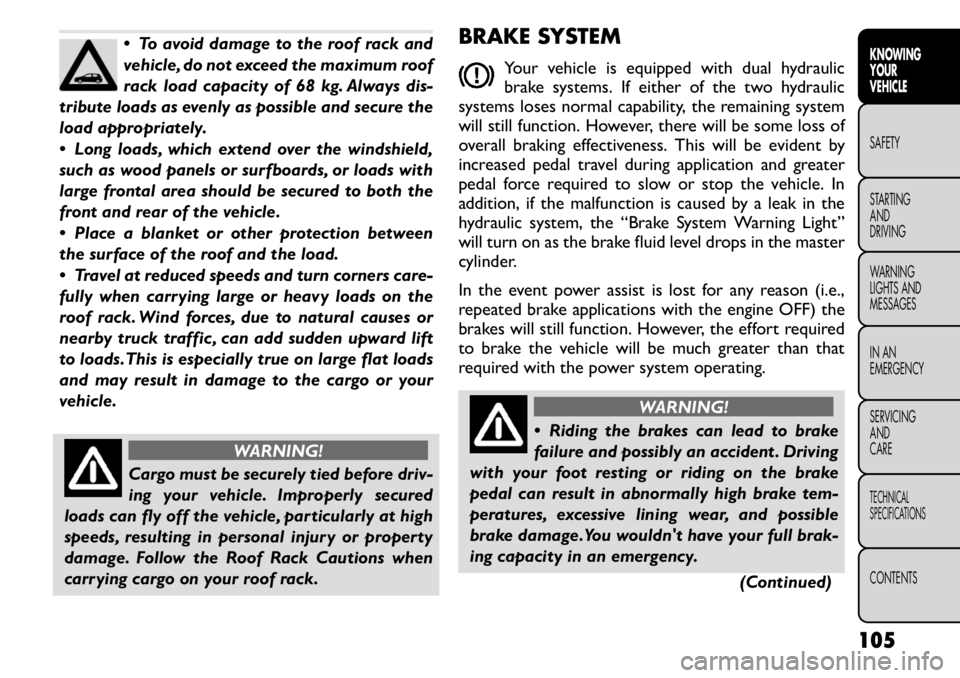
To avoid damage to the roof rack and
vehicle, do not exceed the maximum roof
rack load capacity of 68 kg. Always dis-
tribute loads as evenly as possible and secure the
load appropriately.
Long loads, which extend over the windshield,
such as wood panels or surfboards, or loads with
large frontal area should be secured to both the
front and rear of the vehicle.
Place a blanket or other protection between
the surface of the roof and the load.
Travel at reduced speeds and turn corners care-
fully when carrying large or heavy loads on the
roof rack. Wind forces, due to natural causes or
nearby truck traffic , can add sudden upward lift
to loads.This is especially true on large flat loads
and may result in damage to the cargo or your
vehicle.
WARNING!
Cargo must be securely tied before driv-
ing your vehicle. Improperly secured
loads can fly off the vehicle, particularly at high
speeds, resulting in personal injury or property
damage. Follow the Roof Rack Cautions when
carrying cargo on your roof rack. BRAKE SYSTEM
Your vehicle is equipped with dual hydraulic
brake systems. If either of the two hydraulic
systems loses normal capability, the remaining system
will still function. However, there will be some loss of
overall braking effectiveness. This will be evident by
increased pedal travel during application and greater
pedal force required to slow or stop the vehicle. In
addition, if the malfunction is caused by a leak in the
hydraulic system, the “Brake System Warning Light”
will turn on as the brake fluid level drops in the master
cylinder.
In the event power assist is lost for any reason (i.e.,
repeated brake applications with the engine OFF) the
brakes will still function. However, the effort required
to brake the vehicle will be much greater than that
required with the power system operating.
WARNING!
Riding the brakes can lead to brake
failure and possibly an accident . Driving
with your foot resting or riding on the brake
pedal can result in abnormally high brake tem-
peratures, excessive lining wear, and possible
brake damage.You wouldn't have your full brak-
ing capacity in an emergency.
(Continued)
105KNOWING
YOURVEHICLESAFETY
STARTING ANDDRIVING
WARNING
LIGHTS AND
MESSAGES
IN AN
EMERGENCY
SERVICING AND
CARETECHNICAL
SPECIFICATIONSCONTENTS
Page 181 of 267
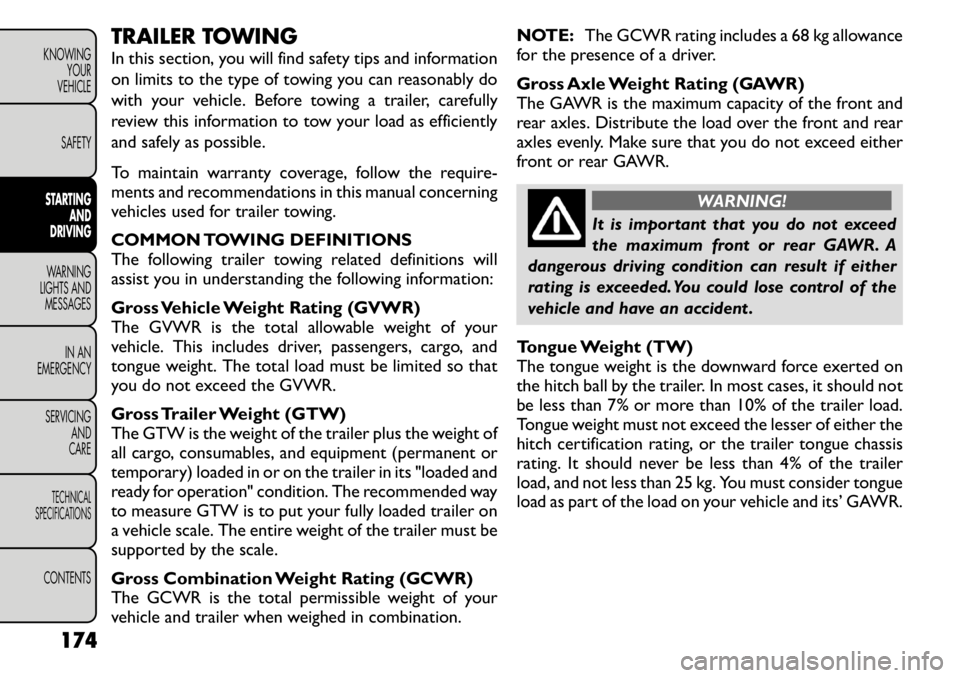
TRAILER TOWING
In this section, you will find safety tips and information
on limits to the type of towing you can reasonably do
with your vehicle. Before towing a trailer, carefully
review this information to tow your load as efficiently
and safely as possible.
To maintain warranty coverage, follow the require-
ments and recommendations in this manual concerning
vehicles used for trailer towing.
COMMON TOWING DEFINITIONS
The following trailer towing related definitions will
assist you in understanding the following information:
Gross Vehicle Weight Rating (GVWR)
The GVWR is the total allowable weight of your
vehicle. This includes driver, passengers, cargo, and
tongue weight. The total load must be limited so that
you do not exceed the GVWR.
Gross Trailer Weight (GTW)
The GTW is the weight of the trailer plus the weight of
all cargo, consumables, and equipment (permanent or
temporary) loaded in or on the trailer in its "loaded and
ready for operation" condition. The recommended way
to measure GTW is to put your fully loaded trailer on
a vehicle scale. The entire weight of the trailer must be
supported by the scale.
Gross Combination Weight Rating (GCWR)
The GCWR is the total permissible weight of your
vehicle and trailer when weighed in combination.NOTE:
The GCWR rating includes a 68 kg allowance
for the presence of a driver.
Gross Axle Weight Rating (GAWR)
The GAWR is the maximum capacity of the front and
rear axles. Distribute the load over the front and rear
axles evenly. Make sure that you do not exceed either
front or rear GAWR.
WARNING!
It is important that you do not exceed
the maximum front or rear GAWR. A
dangerous driving condition can result if either
rating is exceeded. You could lose control of the
vehicle and have an accident .
Tongue Weight (TW)
The tongue weight is the downward force exerted on
the hitch ball by the trailer. In most cases, it should not
be less than 7% or more than 10% of the trailer load.
Tongue weight must not exceed the lesser of either the
hitch certification rating, or the trailer tongue chassis
rating. It should never be less than 4% of the trailer
load, and not less than 25 kg. You must consider tongue
load as part of the load on your vehicle and its’ GAWR.
174
KNOWING YOUR
VEHICLE
SAFETYSTARTING AND
DRIVINGWARNING
LIGHTS AND
MESSAGES
IN AN
EMERGENCY
SERVICING AND
CARETECHNICAL
SPECIFICATIONSCONTENTS
Page 186 of 267
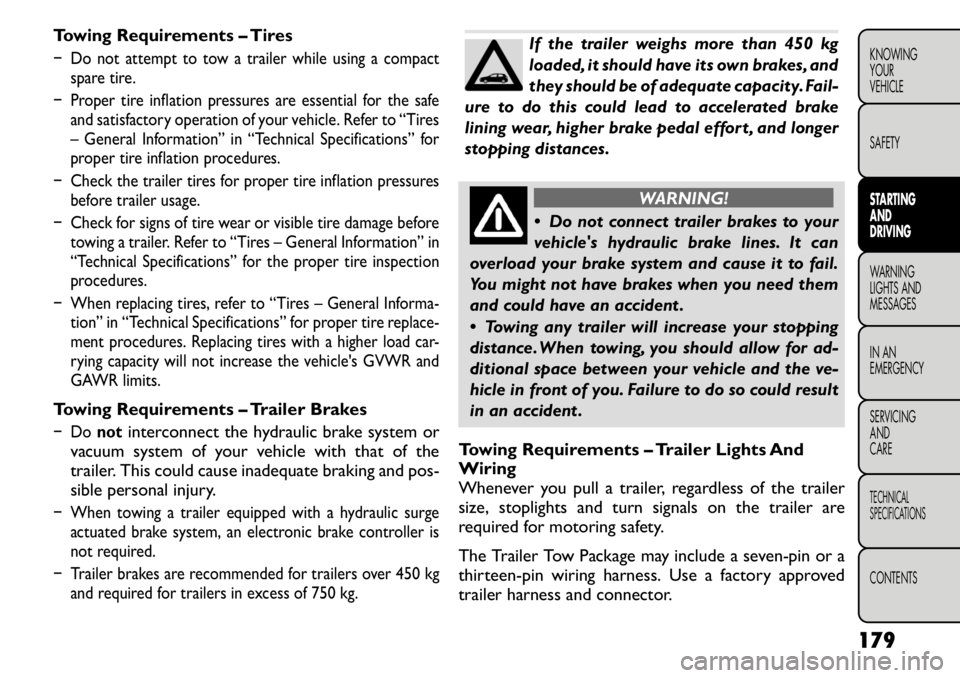
Towing Requirements – Tires� Do not attempt to tow a trailer while using a compactspare tire.
� Proper tire inflation pressures are essential for the safe and satisfactory operation of your vehicle. Refer to “Tires
– General Information” in “Technical Specifications” for
proper tire inflation procedures.
� Check the trailer tires for proper tire inflation pressures before trailer usage.
� Check for signs of tire wear or visible tire damage before towing a trailer. Refer to “Tires – General Information” in
“Technical Specifications” for the proper tire inspection
procedures.
� When replacing tires, refer to “Tires – General Inf orma-
tion” in “Technical Specifications” for proper tire replace-
ment procedures. Replacing tires with a higher load car-
rying capacity will not increase the vehicle's GVWR and
GAWR limits.Towing Requirements – Trailer Brakes� Do not
interconnect the hydraulic brake system or
vacuum system of your vehicle with that of the
trailer. This could cause inadequate braking and pos-
sible personal injury.
� When towing a trailer equipped with a hydraulic surge actuated brake system, an electronic brake controller is
not required.
� Trailer brakes are recommended for trailers over 450 kg and required for trailers in excess of 750 kg.
If the trailer weighs more than 450 kg
loaded, it should have its own brakes, and
they should be of adequate capacity. Fail-
ure to do this could lead to accelerated brake
lining wear, higher brake pedal effort , and longer
stopping distances.
WARNING!
Do not connect trailer brakes to your
vehicle's hydraulic brake lines. It can
overload your brake system and cause it to fail.
You might not have brakes when you need them
and could have an accident .
Towing any trailer will increase your stopping
distance. When towing, you should allow for ad-
ditional space between your vehicle and the ve-
hicle in front of you. Failure to do so could result
in an accident .
Towing Requirements – Trailer Lights And
Wiring
Whenever you pull a trailer, regardless of the trailer
size, stoplights and turn signals on the trailer are
required for motoring safety.
The Trailer Tow Package may include a sev en-pin or a
thirteen-pin wiring harness. Use a factory approved
trailer harness and connector.
179
KNOWING
YOURVEHICLE SAFETYSTARTING ANDDRIVINGWARNING
LIGHTS AND
MESSAGES
IN AN
EMERGENCY
SERVICING AND
CARETECHNICAL
SPECIFICATIONSCONTENTS
Page 243 of 267
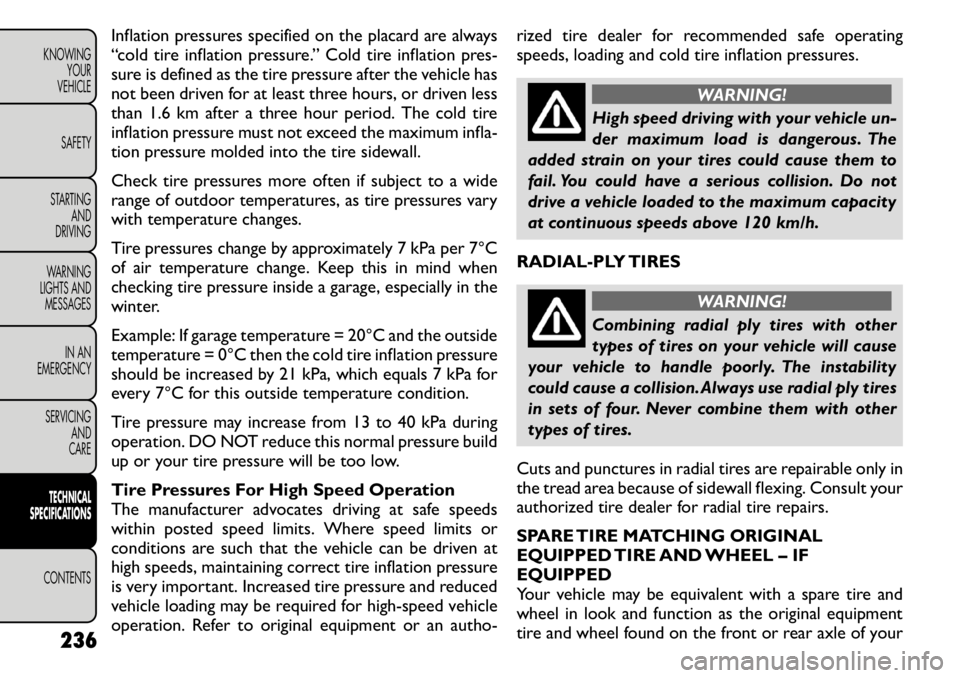
Inflation pressures specified on the placard are always
“cold tire inflation pressure.” Cold tire inflation pres-
sure is defined as the tire pressure after the vehicle has
not been driven for at least three hours, or driven less
than 1.6 km after a three hour period. The cold tire
inflation pressure must not exceed the maximum infla-
tion pressure molded into the tire sidewall.
Check tire pressures more often if subject to a wide
range of outdoor temperatures, as tire pressures vary
with temperature changes.
Tire pressures change by approximately 7 kPa per 7°C
of air temperature change. Keep this in mind when
checking tire pressure inside a garage, especially in the
winter.
Example: If garage temperature = 20°C and the outside
temperature = 0°C then the cold tire inflation pressure
should be increased by 21 kPa, which equals 7 kPa for
every 7°C for this outside temperature condition.
Tire pressure may increase from 13 to 40 kPa during
operation. DO NOT reduce this normal pressure build
up or your tire pressure will be too low.
Tire Pressures For High Speed Operation
The manufacturer advocates driving at safe speeds
within posted speed limits. Where speed limits or
conditions are such that the vehicle can be driven at
high speeds, maintaining correct tire inflation pressure
is very important. Increased tire pressure and reduced
vehicle loading may be required for high-speed vehicle
operation. Refer to original equipment or an autho-rized tire dealer for recommended safe operating
speeds, loading and cold tire inflation pressures.
WARNING!
High speed driving with your vehicle un-
der maximum load is dangerous. The
added strain on your tires could cause them to
fail. You could have a serious collision. Do not
drive a vehicle loaded to the maximum capacity
at continuous speeds above 120 km/h.
RADIAL-PLY TIRES
WARNING!
Combining radial ply tires with other
types of tires on your vehicle will cause
your vehicle to handle poorly. The instability
could cause a collision. Always use radial ply tires
in sets of four. Never combine them with other
types of tires.
Cuts and punctures in radial tires are repairable only in
the tread area because of sidewall flexing. Consult your
authorized tire dealer for radial tire repairs.
SPARE TIRE MATCHING ORIGINAL
EQUIPPED TIRE AND WHEEL – IFEQUIPPED
Your vehicle may be equivalent with a spare tire and
wheel in look and function as the original equipment
tire and wheel found on the front or rear axle of your
236
KNOWING
YOUR
VEHICLE
SAFETY
STARTING AND
DRIVING
WARNING
LIGHTS AND
MESSAGES
IN AN
EMERGENCY
SERVICING AND
CARETECHNICAL
SPECIFICATIONSCONTENTS
Page 247 of 267
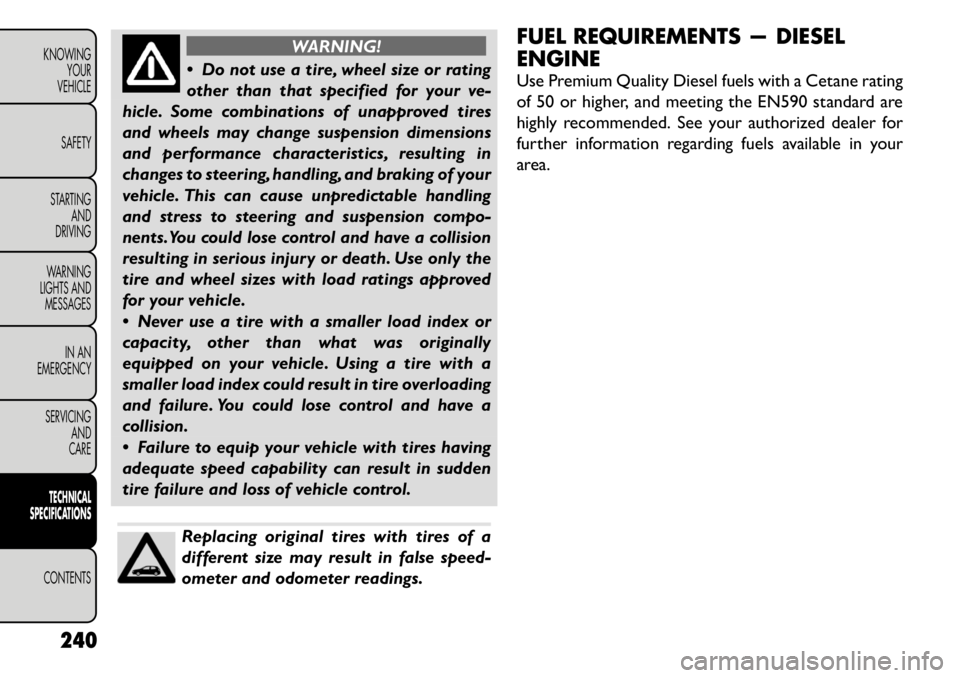
WARNING!
Do not use a tire, wheel size or rating
other than that specified for your ve-
hicle. Some combinations of unapproved tires
and wheels may change suspension dimensions
and performance characteristics, resulting in
changes to steering, handling, and braking of your
vehicle. This can cause unpredictable handling
and stress to steering and suspension compo-
nents.You could lose control and have a collision
resulting in serious injury or death. Use only the
tire and wheel sizes with load ratings approved
for your vehicle.
Never use a tire with a smaller load index or
capacity, other than what was originally
equipped on your vehicle. Using a tire with a
smaller load index could result in tire overloading
and failure. You could lose control and have a
collision.
Failure to equip your vehicle with tires having
adequate speed capability can result in sudden
tire failure and loss of vehicle control.Replacing original tires with tires of a
different size may result in false speed-
ometer and odometer readings. FUEL REQUIREMENTS — DIESEL ENGINE
Use Premium Quality Diesel fuels with a Cetane rating
of 50 or higher, and meeting the EN590 standard are
highly recommended. See your authorized dealer for
further information regarding fuels available in your
area.
240
KNOWING YOUR
VEHICLE
SAFETY
STARTING AND
DRIVING
WARNING
LIGHTS AND
MESSAGES
IN AN
EMERGENCY
SERVICING AND
CARETECHNICAL
SPECIFICATIONSCONTENTS
Page 255 of 267

Camera, Rear . . . . . . . . . . . . . . . . . . . . . . . . . . . 124
Capacities, Fluid . . . . . . . . . . . . . . . . . . . . . . . . . 241
Caps, FillerFuel . . . . . . . . . . . . . . . . . . . . . . . . . . . . . . . . 130
Oil (Engine) . . . . . . . . . . . . . . . . . . . . . . . 218,219
Power Steering . . . . . . . . . . . . . . . . . . . . . . . . 113
Radiator (Coolant Pressure) . . . . . . . . . . . . . . . 227
Car Washes . . . . . . . . . . . . . . . . . . . . . . . . . . . . 230
Carbon Monoxide Warning . . . . . . . . . . . . . . . . . 163
Cargo (Vehicle Loading) . . . . . . . . . . . . . . . . . . . . 100
Cargo Area Cover . . . . . . . . . . . . . . . . . . . . . . . 101
Cargo Area Features . . . . . . . . . . . . . . . . . . . . . . . 99
Cargo Compartment . . . . . . . . . . . . . . . . . . . . . . . 99 Light . . . . . . . . . . . . . . . . . . . . . . . . . . . . . . . . 99
Luggage Carrier . . . . . . . . . . . . . . . . . . . . . . . . 104
Cargo Load Floor . . . . . . . . . . . . . . . . . . . . . . . . 100
Cargo Management System . . . . . . . . . . . . . . . . . . 100 Rollaway Tonneau Cover . . . . . . . . . . . . . . . . . . 101
Tri-Fold Load Floor . . . . . . . . . . . . . . . . . . . . . 100
Cargo Tie-Downs . . . . . . . . . . . . . . . . . . . . . . . . 100
Cellular Phone . . . . . . . . . . . . . . . . . . . . . . . . . . 130
Changing A Flat Tire . . . . . . . . . . . . . . . . . . . . . . 193
Checking Your Vehicle For Safety . . . . . . . . . . . . . . 162
Checks, Safety . . . . . . . . . . . . . . . . . . . . . . . . . . 162
Child Booster Seat . . . . . . . . . . . . . . . . . . . . . . . 144
Child Restraint . . . . . . . . . . . . . . 141,143,145,149,151
Child Restraint Tether Anchors . . . . . . . . . . . . 146,149
Child Safety Locks . . . . . . . . . . . . . . . . . . . . . . . . 92Cleaning Wheels . . . . . . . . . . . . . . . . . . . . . . . . . . . . . 231
Windshield Wiper Blades . . . . . . . . . . . . . . . . . 223
Climate Control . . . . . . . . . . . . . . . . . . . . . . . . . . 56
Coin Holder . . . . . . . . . . . . . . . . . . . . . . . . . . . . 79
Cold Weather Operation . . . . . . . . . . . . . . . . . . . 168
Compact Disc (CD) Maintenance . . . . . . . . . . . . . 129 Compact Spare Tire . . . . . . . . . . . . . . . . . . . . . . 237
Computer, Trip/Travel . . . . . . . . . . . . . . . . . . . . . . 23
Connector
UCI . . . . . . . . . . . . . . . . . . . . . . . . . . . . . . . . 129
Universal Consumer Interface (UCI) . . . . . . . . . . 129
Conserving Fuel . . . . . . . . . . . . . . . . . . . . . . . . . . 22
Console, Floor . . . . . . . . . . . . . . . . . . . . . . . . . . . 79
Console, Overhead . . . . . . . . . . . . . . . . . . . . . . . . 77
Cool Down, Turbo . . . . . . . . . . . . . . . . . . . . . . . 168
Coolant Pressure Cap (Radiator Cap) . . . . . . . . . . . 227
Cooling System . . . . . . . . . . . . . . . . . . . . . . . . . 226 Adding Coolant (Antifreeze) . . . . . . . . . . . . . . . 227
Coolant Capacity . . . . . . . . . . . . . . . . . . . . . . . 241
Coolant Level . . . . . . . . . . . . . . . . . . . . . . 226,228
Diesel Engine . . . . . . . . . . . . . . . . . . . . . . . . . 226
Disposal of Used Coolant . . . . . . . . . . . . . . . . . 227
Drain, Flush, and Refill . . . . . . . . . . . . . . . . . . . 226
Inspection . . . . . . . . . . . . . . . . . . . . . . . . . . . 228
Points to Remember . . . . . . . . . . . . . . . . . . . . 228
Pressure Cap . . . . . . . . . . . . . . . . . . . . . . . . . 227
Radiator Cap . . . . . . . . . . . . . . . . . . . . . . . . . 227
Selection of Coolant (Antifreeze) . . . . . . 226,241,242
Temperature Gauge . . . . . . . . . . . . . . . . . . . . . . . 7
Corrosion Protection . . . . . . . . . . . . . . . . . . . . . 230
Cupholders . . . . . . . . . . . . . . . . . . . . . . . . . . 85,232
Data Recorder, Event . . . . . . . . . . . . . . . . . . . . . 161
Daytime Brightness, Interior Lights . . . . . . . . . . . . . 69
Daytime Running Lights . . . . . . . . . . . . . . . . . . . . . 67
Defroster, Rear Window . . . . . . . . . . . . . . . . . . . . 74
Defroster, Windshield . . . . . . . . . . . . . . . . . . . 60,164
Delay (Intermittent) Wipers . . . . . . . . . . . . . . . . . . 70
Diagnostic System, Onboard . . . . . . . . . . . . . . . . . 111
Diesel Fuel . . . . . . . . . . . . . . . . . . . . . . . . . . 240,242
Diesel Fuel Requirements . . . . . . . . . . . . . . . . . . . 240
248
KNOWING
YOUR
VEHICLE
SAFETY
STARTING AND
DRIVING
WARNING
LIGHTS AND
MESSAGES
IN AN
EMERGENCY
SERVICING AND
CARETECHNICAL
SPECIFICATIONSCONTENTS